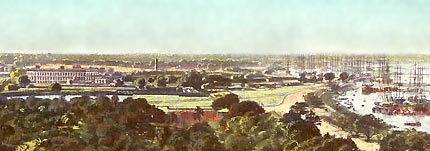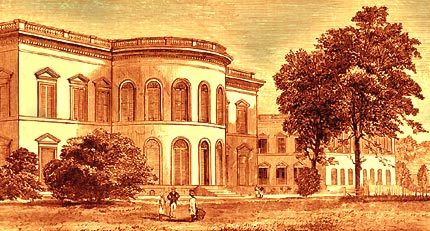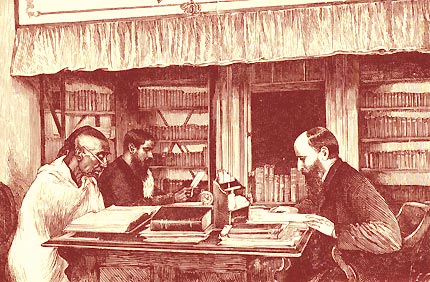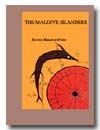|
5 December 2003
By: Simon Fuller

Fort William buildings
from 1816 medal |
Maldives is Sri Lanka's nearest neighbour, with
the exception of South India. The two countries have many historical
and cultural links, and Divehi, the language of the Maldivian people,
is the nearest relative of Sinhala. But unlike Sinhala and the major
South Indian languages which have very long histories of Bible translation,
it is generally assumed that Divehi has no such history.
The purpose of this paper is to reconstruct the circumstances surrounding
a little known early translation which was partially completed but
finally abandoned, and to explore the possibility of its survival
to the present day.

John Leyden memorial
Denholm, Scotland |
In 1803 the Scottish poet and linguist John Leyden
(1775-1811) reached India, and immediately set about studying and
analysing the languages of the Subcontinent and the Far East, whilst
holding various senior government posts. The extent of his ability
can be judged by the fact that, although he died at only 36, his
biographer estimates that he was competent in no less than forty-
five languages.
His connection with Divehi began, apparently unintentionally, whilst
on a sea voyage from Quilon (in Kerala) to Malaysia in October 1805.
In his own words he records:
"On my Voyage from Travancore to Pooloo
Penang ..., as there happened to be several intelligent natives
of the Maldives on board, I took every opportunity of making enquiry
concerning these islands that a very tempestuous passage, a very
bad state of health and very imperfect means of communication
permitted."
Amongst the notes he compiled was a classified
vocabulary of some 350 words in English and Divehi. The presence
of dialect words and the style of the script employed suggest that
these first Maldivians Leyden met may have been from Minicoy (in
Divehi, Maliku), an island to the north of Maldives and under Indian
administration although populated by Maldivians.

Fort William, Calcutta |
From circa 1806 onwards, Leyden held a post as
Professor of Hindustani at Fort William College, Calcutta. Here
he employed a number of language informants, apparently including
one or more Maldivians, who would have come to Bengal on trading
expeditions.
Here also he would have moved closely with the pioneer missionary
William Carey, who although based at Serampore, some 20 miles to
the north, was also Professor of Bengali and Sanskrit at Fort William
College; and with the Rev. David Brown, the provost of the College,
who was also the Senior Chaplain of the Presidency of Bengal, Secretary
of the Calcutta Corresponding Committee of the British and Foreign
Bible Society, and later of the Calcutta Auxiliary Bible Society.
With such connections, it was probably inevitable that Leyden, although
his motives had been primarily academic, should have been drawn
into the work of Scripture translation. In March 1810, Leyden wrote
to Rev. David Brown, offering to have translations made of the four
Gospels into seven languages including Divehi (Maldivian) The others
were Thai, Pashto (Afghanistan), Arakanese (Burma), Makassar and
Bugis (Indonesia), and Jagatai (Central Asia) Leyden's informants,
who were mother-tongue speakers of these languages, would do the
translation, and he himself would be responsible for co-ordinating
the work, correcting, and collating the translation with the Greek
originals.
The Corresponding Committee of the Bible Society gladly accepted
Leyden's offer, and agreed to pay Rs.200 for each Gospel completed,
in order to cover expenses. The Divehi translation seems to have
made very rapid progress; on July 20, 1810, Leyden wrote again to
Brown:
"I beg you will do me the favor to submit
to the Committee the accompanying Papers, which I forward by way
of reporting progress in the Translation of the Gospels, which
I undertook to superintend. They consist of the Gospel of Matthew,
from the beginning to the end of the 18th Chapter, in the Maldivian
language... the Maldivian has been corrected and collated with
the Greek, up to the two last chapters; but the sickness of my
writer prevented me from having a fair copy made out, of any more
than the first 18 chapters. Having very few specimens of style
in Maldivian, I cannot speak so confidently of this translation,
but as I daily expect a supply of MSS. It will be improved while
the rest are in progress."
The Divehi translation continued to advance
ahead of the other languages Leyden had promised; before leaving
Calcutta in March 1811 as an interpreter attached to an expeditionary
force to Java, Leyden delivered to David Brown the manuscripts of
9 Gospels in various languages, including Matthew, Mark, Luke and
the second part of John in Maldivian.
However in Java, Leyden was taken sick, and on August 28 1811 he
died of fever at Batavia (Jakarta) This tragedy left a gap which,
as the Bible Society realised, would probably not be filled. However,
the reaction of the Corresponding Committee at Calcutta was one
of looking to God in faith:
"The Corresponding Committee... do not
consider the expense incurred by their engagements with Dr. Leyden,
to be wholly lost. In their varied and extensive plans, they cannot
reasonably expect an uninterrupted course of success. Moving in
paths untried before, they are prepared for disappointments. They
are not surprised, if they meet with unforeseen delays in the
execution of the most approved plan; if important objects are
defeated, even in the outset; and if sums are occasionally expended
in undertakings which may turn out to be of distant than of immediate
utility. And they deem it a point of no small consequence to lay
a foundation on which future generations may build."
Leyden's Maldivian translator stayed on at Calcutta,
possibly working for a time directly under David Brown. However,
on June 14th 1812, only ten months after the loss of Leyden, the
work suffered another blow by the death of Brown. At this point,
the Bible Society seems in effect to have shelved the project; members
attending the Eighth Annual General Meeting in London were regretfully
informed:
"Of the Gospels... translated by Dr. Leyden...
none have been printed; but the death of Dr. Leyden in Java...
must now delay the publication of them, as they cannot be committed
to the press without the revision of a European scholar."
| 
Serampore College
|
However, the Serampore (Baptist) missionaries,
who already collaborated closely with the Bible Society's work in
India, stepped in. In the Memoir on Translations printed in their
Circular Letter of August 1813, William Carey and his associates
wrote:
"The late Dr. Leyden had made some progress
in ascertaining the nature of this [Maldivian] language; and after
his death, the learned native he employed coming to us, we thought
such an opportunity of giving the Word of Life in the language
of these numerous isles ought not to be lost, as it might not
occur again for many years: we therefore retained him. He is well
acquainted with Hindoost'hanee, which renders the communication
with him easy. In this [Maldivian] language the Gospels are finished;
and we have nearly completed a font of types in this alphabet..."
This font of types, the first, and to this day
the only, set ever prepared for letterpress printing of the unique
Thaana script used for Divehi, was duly completed, and the Gospels
were on the point of printing; in fact a Report giving the progress
in translation work up to June 1814 goes as far as to state, "Maldivian.
The Gospels are translated, Matthew in the press."
Yet, somehow, the anticipated printing never began; the manuscript
was laid on one side; and within a few years all mention of the
project had disappeared from the bulletins and circulars describing
the progress of the Serampore mission. The last significant mention
I can find is in a publication of 1818, "Specimens of Editions
of the Sacred Scriptures in the Eastern Languages, translated by
the Brethren of the Serampore Mission; and of several others."
This booklet illustrates the Lord's Prayer in some 48 Asian languages;
but under the heading "9. In Maldivian," instead of the
Lord's Prayer, there is simply the bald paragraph:
"The types for printing in this Language
were prepared several years ago, but owing to the native of the
islands having left us to go to his own country and our not having
since been able to procure another, the printing could not be
begun."
Presumably, in their concern for textual accuracy,
especially bearing in mind that the translation was intended for
a Muslim people with their high view of Scripture, the missionaries
felt unable to proceed with printing without any proof-reader.

Serampore College
|
That the Maldivian translator's untimely
departure was made under some pressure, can be gathered from a comment
of Lieutenant W. Christopher, a British officer (and apparently
a devout Christian) associated with the British Admiralty Survey
of the Maldives in 1835. Christopher, together with another officer
I. A. Young, were sent ashore to gather information on the Maldivians'
culture and language, and spent several weeks in Male the capital.
There he happened to meet the Maldivian translator. He described
the incident in a note to the Rev. John Wilson at Bombay accompanying
a Vocabulary of Divehi (1838) which was published in 1841 , and
although his information is incomplete, he is unmistakably referring
to the same translation:
"So averse are the island authorities
to anything like emigration, that a laudable attempt to translate
the New Testament, by means of a Hindustani Munshi, failed at
Bengal, the man who was engaged having been recalled by the Sultan
of Mali, before the Gospel of Matthew was gone through. I have
seen and conversed with the Maldivian above referred to (he is
now venerably gray), and he spoke of his engagement under the
Rev. Mr. Brown, with readiness and evident self-gratulation. This
translation (so far as it goes) is, I believe, in the hands of
the Serampore Missionaries."
Apparently the then-reigning Sultan Muhammad
Mu'inuddeen I (1799-1835), described by the historian of Maldives
H.C.P. Bell as "narrow-minded and suspicious of European contact",
had sent some message warning his subject to return home immediately,
and the translator obeyed through fear of the consequences if he
did otherwise. By the time of Christopher's visit in 1835 this Sultan
had just died, and the Maldivian felt free to speak of what had
happened.
Not surprisingly, however, the frustrated missionaries at Serampore
had been unable to find another Maldivian willing or able to take
his place; and hence the project which had progressed so far was
simply abandoned.
|
Editor's
note
In the late 18th
until the early 20th centuries there was a prominent clan
of learned navigators, mathematicians and astronomers in Malé
whose ancestors came from the island of Himithi. The most
well-known of them was Himithi Ismail Kaleygefanuge Tuttu
who died in the early 1960s. The Himithi clan and their associates
ran a successful navigation school in Malé in the 19th
century. My paternal grandmother was a graduate of that school,
unusual for a young Maldive woman of that period. It is most
likely the Bible translator was a member of the Himithi clan
of navigators. |
We have a clue to the probable identity of the
Maldivian informant and translator, through a book formerly belonging
to Leyden's personal collection, and now kept in the Library of
the India Office, London. This is a volume printed in Calcutta in
1808 by the Hindoostanee Press, which worked in close co-operation
with the College of Fort William. The book is entitled A Vocabulary,
Persian and Hindoostanee, to which the words "and Maldivian"
have been added in pencil. To the original Persian and Hindustani
words, an individual identified as one Hasan bin Adam, of Himithi
Island in North Nilandhe (now Faafu) Atoll, has added Divehi equivalents.
We already know that the Maldivian informant working with Leyden
and Brown and then at Serampore used Hindustani as a means of communication;
furthermore the date of this volume (1808) accords well with Leyden's
claim that the persons assisting him in his literary researches
had been "practised in the work of translation" and were
"engaged in preparing Vocabularies and Grammars", prior
to his letter to Brown offering the Gospel translations in March
1810. It seems more than likely therefore that Hasan bin Adam was
Leyden's Divehi-speaking assistant in Calcutta, and hence the one
mainly responsible for the Divehi translation of the Gospels.
The passing reference made by Christopher, published in the Royal
Asiatic Society Journal of 1841, quoted above, prompted the Secretary
of the Ceylon Branch of the Royal Asiatic Society, Mr. H.C.P. Bell,
who devoted many years of his life to a detailed study of the Maldives,
in 1887 to initiate a search for the lost Maldivian Scriptures.
However, being based in Colombo, he had no access to archives and
records which would have helped him in his search. His complete
correspondence with Serampore College was later printed in the Ceylon
Observer of January 14, 1925:
A) Rev. Edward S. Summer to Mr H.C.P. Bell
Serampore College,
February 8, 1887
Dear Sir,
Mr Stevens of the R.A.S. (C.S.) has communicated with me about a
Maldivian MS. of the Gospels supposed to be on our shelves, and
which you wished to obtain a sight of. I am sorry that I can find
no trace of it, and doubt whether it is here, as it is not down
in the Catalogue of Scriptures. If, however, we have it, and I should
come across it, I will communicate with you again.
Yours truly,
(Sgd.) EDWARD S. SUMMER,
Principal
B) Mr H.C.P. Bell
to Rev E.S. Summer.
Colombo,
March 1, 1887
Dear Sir,
I have to thank you for your Post Card of the 8th ultimo, which
took some time reaching me. Mr. Stevens on his way through Ceylon,
after his visit to India, informed that he had been himself to Serampore,
and handed over my letter - though I am not sure whether to yourself
or to an assistant. I have been anxious to learn whether my quest
was likely to be successful.
Your Post Card, though not encouraging, leaves me still some hope
that the long- buried Maldive MS. may yet come to light in the archives.
As perhaps you are aware, I have for some years tried to make a
special study of the Maldive Islands, our sole dependancy; and have,
to some extent, mastered their peculiar script and language with
the help of my Maldive friends. There is no Maldivian literature
beyond lithographed MS. books, half Arabic, on their religion; songs
and the stray letters on business matters, which reach Agents in
Ceylon.
The discovery of this Maldive MS. of St. Mathew's Gospel would be
of very great interest, and I trust you will kindly aid me to obtain
a sight of it, by having renewed search made on your bookshelves
etc. Once obtained I would endeavour to transliterate it myself,
and make such further use of it, as you might advise.
My authority for believing the MS. to be with your Mission at Serampore
is the following extract from a paper by Lieut. Christopher, I.N.,
communicated to the R.A.S. of England (Journal Vol.VI o.s., p.43):
"So averse are the island authorities
to anything like emigration, that a laudable attempt to translate
the New Testament, by means of a Hindustani Munshi, failed at
Bengal, the man who was engaged having been recalled by the Sultan
of Male, before the Gospel of Matthew was gone through. I have
seen and conversed with the Maldivian above referred to (he is
now venerably gray), and he spoke of his engagement under the
Rev. Mr. Brown, with readiness and evident self-gratulation. This
translation (so far as it goes) is, I believe, in the hands of
the Serampore Missionaries."
The extract will perhaps serve as some clue to
the lost MS. Christopher was writing in 1836. When did this "Rev.
Mr. Brown" work at Serampore? Could he not have put something
on record touching the "engagement" with the Maldivian?
Trusting to hear from you shortly that the MS. has been unearthed,
and is at my service (subject to your conditions)
Believe me, yours truly,
(Sgd.) H.C.P. BELL,
Hon. Secretary R.A.S.C.B.
C) Rev. E.S. Summer to Mr. H.C.P. Bell
Serampore College
March 29, 1887.
Dear Sir,
Your letter of March 1, though under difficulty as regards time
(for I am leaving for England tomorrow) I write a few lines to say
that I think there is no hope of recovering the desiderated MS.
After reading your reason for supposing that it was at Serampore
College I am satisfied that it is not. Dr. Brown was not a Serampore
College Missionary at all; though I think there was a Church of
England Chaplain of that name somewhere about that time. The centre
of our Mission and of our translation work has long since been removed
from Serampore, and this work (if it ever was at Serampore) has
either ceased to exist, or has been removed somewhere else; and
I can offer no suggestion as to whether, or where, it can now be
found.
I am very sorry that I cannot help you in the matter, and must end
with expressing the hope that a translation of the Scriptures, or
some portion of them, in the Maldivian language may ere long be
made. Linguists can have no nobler occupation.
Yours truly,
(Sgd.) EDWARD S. SUMMER
What is extraordinary about this correspondence is that the authorities
at Serampore in 1887 should virtually disclaim all knowledge of
the existence of the translation, and even of the identity of the
'Rev. Mr. Brown', who is clearly identifiable as the Rev. David
Brown, the founder of the Calcutta Auxiliary Bible Society.
More than a century later, we can today only speculate whether if
a more thorough investigation had been made at that stage, some
vital clue might not have come to light as to the whereabouts of
the lost Gospels.
Another area of interest, although perhaps not directly relevant
to the history of this particular manuscript, concerns the circumstances
leading to Bell's 1887 correspondence being published in 1925. A
certain Mrs K. Wood Kumarakulasinghe of Nuwara Eliya, together with
her husband, who was "in government service", had been
for some time concerned to share the Gospel with the Maldivians.
Mr. Kumarakulasinghe had attempted a fresh translation of the Scriptures
into Divehi. Exactly how far this progressed or what was the fate
of his manuscripts I do not yet know, but once again, as with Leyden,
the work was cut short by his death. Mrs Kumarakulasinghe had attempted
to continue the work, but again unsuccessfully. Finally she had
expressed her concern to Sir Anton Bertram, the Vice-President of
the Ceylon Auxiliary Bible Society.
Addressing a meeting of the Society at Kandy on January 2 1925,
Bertram referred to Mrs Kumarakulasinghe's correspondence, and it
was reading the published text of this speech in the Times of Ceylon
of January 5 1925 that prompted H.C.P. Bell to submit his correspondence
with Serampore College for publication, simply to demonstrate that
a previous attempt to translate the Scriptures for the Maldivians
had been made.
What, then, was the fate of the 1811 Divehi Gospels?

Parts of the New Testament are being translated and published
by the Bible Society of Maldives. The Maldives Supreme Council
for Islam has issued a fetwa banning these
publications |
C.E. Wilson, in his commemorative booklet 'A
Century and a Half of Bible Translation' by the Baptist Missionary
Society (1942) gives a drastic answer. He explains that Leyden's
Four Gospels in Maldivian were never issued because both fonts and
manuscript were destroyed in the disastrous fire which gutted the
Serampore printing-house on March 11 1812. But, although it would
be interesting to know Wilson's basis for such a claim, we must
reject it on two counts:
- Very detailed accounts were issued by the Serampore missionaries
of everything that had been lost in the fire - which did include
several fonts and manuscripts - but the Maldivian materials are
not mentioned.
- The references made by the Serampore missionaries to the Maldivian
manuscripts all date from after this event. The Brief Narrative
of the Baptist Mission in India (Fourth edition, 1813), in a list
of translations engaged in as of June 1812, the month of David
Brown's death and three months after the fire, makes no reference
to Divehi. However a letter of William Carey dated November 1812
is referred to which speaks of "no less than eighteen translations,
some of which have fallen into their hands by the death of other
translators." This presumably includes the Divehi gospels.
The earliest explicit Serampore reference I have found is in the
Preface to Volume V of the Periodical Accounts relative to the
Baptist Missionary Society, which summarized the state of progress
at the close of 1812. In the field of translation, 'Maldivian'
has appeared on the end of the list (no. 18) of languages being
worked on, with the comment, "commencing". This would
clearly be impossible if the work had been destroyed in March
1812, at which date the manuscripts were almost certainly in the
hands of Rev. David Brown at the Bible Society.
Another possible scenario, suggested to me by
a Maldivian resident, is that the controversial manuscripts were
removed from Serampore to Malé on the orders of the Maldivian
government as a condition for the translator's pardon, and there
scrutinized and subsequently destroyed. However this would seem
to be ruled out by the apparent implication of the last Serampore
references to the effect that the missionaries still had the translation
though not the translator.
Since there is thus no conclusive evidence of the end which befell
the manuscripts, in principle we may not totally rule out the possibility
that they may yet be preserved somewhere in Calcutta or Serampore.
However having searched in all the likely institutions in Calcutta
and Serampore and found no trace of the manuscripts, I regretfully
concluded that the ravages of climate and environment make it most
unlikely that these unique documents could have survived to the
present day.
First published on the Internet in www.maldivesculture.com
Photos from Wallace in Scotland, Carey Center Portrait Gallery,
and Ronald Ellis's Photographs and Images of Calcutta and the Baptist
Mission Press
|




 rss feed
rss feed 






